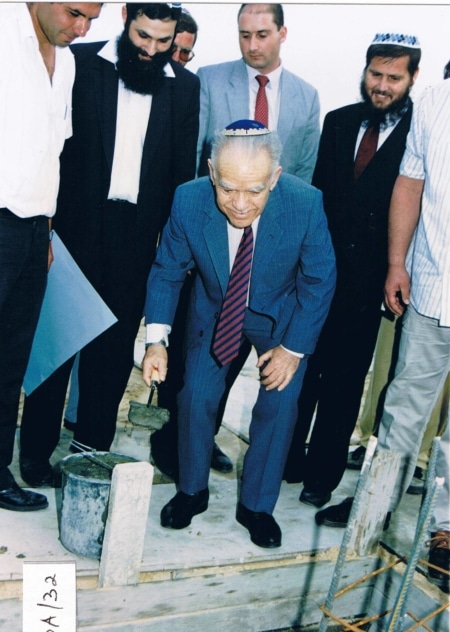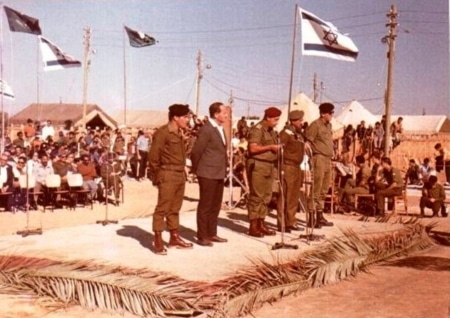The first Yitzhak Rabin government fully continued the Golda government policy regarding communities beyond the “Green Line” according to the Alon Plan, including Jewish communities in the Gaza Strip. On December 16, 1975, the Kfar Darom outpost was naturalized not as a permanent community but as a temporary transit camp for Gush Katif residents.
On February 10, 1977, Netzer Hazani was naturalized and named after the late Minister of Welfare in the Rabin government, Michael Hazani, who was a supporter of settling the region.  In his speech in the naturalization ceremony, Rabin expressed his core beliefs regarding the southern Gaza Strip which later became Gush Katif: “This is a great day for the state and settlement, a day that symbolizes the establishment of our hold on the region, which since the Six Day War has become an integral part of the state and its security.” Rabin did not change his position regarding the security importance of the Jewish communities of Gush Katif and continued to hold this position nine years later. As Minister of Defense in the Peres government, he visited Gush Katif. Since the communities were already established, he also addressed the economic and social aspects that had not been an issue before. Rabin told the Gush Katif residents: “Like nine years ago…. so, also, today I believe that this area has a settling, economic, social and security role – and it must be an integral part of the State of Israel. “
In his speech in the naturalization ceremony, Rabin expressed his core beliefs regarding the southern Gaza Strip which later became Gush Katif: “This is a great day for the state and settlement, a day that symbolizes the establishment of our hold on the region, which since the Six Day War has become an integral part of the state and its security.” Rabin did not change his position regarding the security importance of the Jewish communities of Gush Katif and continued to hold this position nine years later. As Minister of Defense in the Peres government, he visited Gush Katif. Since the communities were already established, he also addressed the economic and social aspects that had not been an issue before. Rabin told the Gush Katif residents: “Like nine years ago…. so, also, today I believe that this area has a settling, economic, social and security role – and it must be an integral part of the State of Israel. “
His successor, Menachem Begin, agreed in the peace agreement with Egypt to a full withdrawal from the entire Sinai Peninsula to the international border, but refused to withdraw from the Gaza Strip – an integral part of Israel. On January 8, 1980, at a meeting held by Begin with Sadat in the Egyptian city of Aswan after signing the peace agreement, Sadat spoke about his special responsibility to Gaza and his desire to “free it from the occupation”. Begin responded: “What occupation? … This is not a foreign land … This is the Land of Israel.”
Yitzhak Shamir, Menachem Begin’s successor, also saw the Gaza Strip as an integral part of Israel and attached special importance to settling there. According to him: “The communities here came to register the principle that there is not and will not be a corner in the Land of Israel that will be closed to Jewish settlement.”
Yitzhak Shamir visited the Jewish communities in the Gaza Strip several times. During a visit to Gush Katif in June 1987, he said in an interview to the Gaza Strip communities’ Gazette: “I was very impressed by the dynamism of the place. There is a tremendous effort here to move forward and overcome [all difficulties], and the efforts are worthy of all support and assistance.”
The Arab Intifada created a new reality in Gush Katif, but the communities grew stronger. Although new communities were not established during the unity government, the population continued to grow in the existing communities. Yitzhak Shamir remained steadfast in his view regarding the Gaza Strip and opposed initiatives by Likud MKs to withdraw from the Gaza Strip in the form of “Gaza First.”
Yitzhak Rabin, during the Oslo process, also established the bloc principle that Gush Katif would be outside the PA autonomy, and under full Israeli control (although he noted that communities such as Netzarim and Kfar Darom could not be included in the settlement blocs due to their location). Most of the Jewish communities remained in two main settlement blocs: Gush Katif in the southern part of the region; and the northern settlement bloc – Eli Sinai, Nissanit and Dugit. The communities of Kfar Darom and Netzarim remained isolated and cut off from the blocs. Rabin continued to advocate to maintain Israeli control of the Gush Katif communities in in the southern Gaza Strip and in the three communities in the north. At a press conference held in Gush Katif in November 1994, he praised the residents of Gush Katif and especially the residents of Netzarim “who stand with dignity during this difficult period and continue their lives in a reality that is not simple.”
On October 5, 1995, a month before he was assassinated, Rabin presented the Oslo Accords B to the Knesset for approval. In his speech, Rabin outlined his updated political ‘I believe’ following the Oslo Accords. On the issue of settling in Judea (Yehuda) and Samaria (the Shomron), he said: “To establish settlement blocs, and I wish there were like them, like Gush Katif, also in Judea and Samaria.” Moreover, he said: “I want to remind you: we promised – meaning, we reached an agreement – we promised before the Knesset not to uproot a single community in the framework of the interim arrangement, also not to freeze construction and natural growth. “
As is well known, Prime Minister Ariel Sharon led the Disengagement Plan in 2005. Sharon announced that “by the end of 2005, no Jew will remain in the Gaza Strip.” Did this end thousands of years of a connection between the Jewish people and Gaza, or will this historic dynamic have additional effects in the near or distant future? The Minister of History can supply the answers.

(From the Gaza Strip and the Southern Border of the State of Israel – Hagai Huberman – The Jewish Community of Gaza Published by the Gush Katif Heritage Center 2019)






